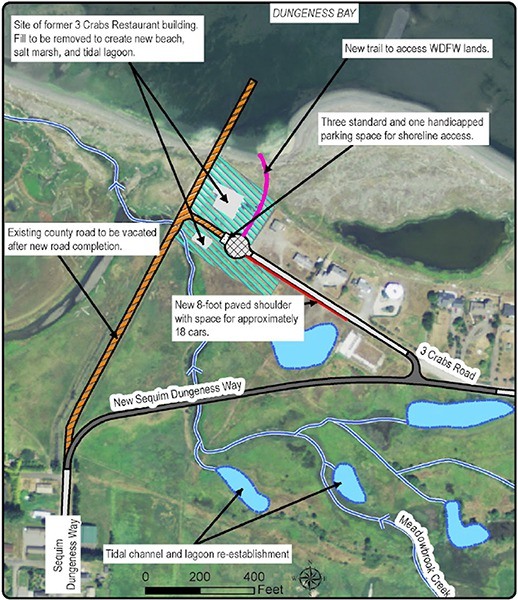Making way for restoration work at the former site of The 3 Crabs restaurant, Clallam County commissioners agreed to give up portions of two county roads.
Pending a new road meets conditions and safety standards, 1,475 feet of Sequim-Dungeness Way and 132 feet of 3 Crabs Road will be vacated and removed.
Rebecca Benjamin, North Olympic Salmon Coalition executive director, called the agreement a “big deal” following the commissioners’ decision.
“It means we can proceed with the project and finalize the designs,” Benjamin said.
As one of 14 Regional Fisheries Enhancement Groups within the state dedicated to salmon recovery, the North Olympic Salmon Coalition is a community-based nonprofit organization that works with landowners to perform salmon habitat restoration on the North Olympic Peninsula.
Scope of project
For years, coalition officials have pursued the nearshore and estuarine restoration project to improve the ecology of more than 40 acres of coastal wetlands, a half-mile of stream channel and public access to Washington Department of Fish and Wildlife-owned land.
To do so, the grant-supported project seeks to revert the area to a more pre-developed state by, but not limited to, setting sections of roadway back from the bay’s shoreline, reshaping and reconnecting parts of the Meadowbrook Creek channel to adjacent sloughs, removing 800 feet of dike and 80 feet of rip rap (rock and/or concrete rubble used to armor shorelines) along the creek’s banks, installing engineered log jams and removing the building’s foundation and buried septic tanks.
Before the estimated $2.98 million construction phase set to begin in April 2016 could move ahead, however, the project needed a road vacation agreement with the Clallam County commissioners and public hearing.
On Sept. 15, commissioners approved the road vacations contingent on the new road meeting standards. County engineer Ross Tyler called it an “odd” way of approaching road vacations, because the actual act of vacating the roads won’t happen until about this next year, he said.
“But, in this particular case and the way this project is set up the proponents don’t want to invest the considerable sum of money in building this road unless the board (of county commissioners) is willing to consider vacating,” Tyler said.
Based on the new road design, Tyler said he expects the new road to be an improvement. The design uses modern road building standards, replaces an old and undersized creosote bridge across Meadowbrook Creek with a 61-foot concrete arch bridge and is built on ground averaging 1 foot higher in elevation — thus helping to eliminate periodic flooding.
“From an engineering, road department and transportation standpoint, the new road plan looks really good,” Tyler said. “I have no fears it won’t work out as planned.”
A 2-1 vote
Commissioner Mike Chapman was opposed to conditionally vacate the sections of road, but commissioners Jim McEntire and Bill Peach were supportive during the Sept. 15 vote, allowing the project to proceed.
“I’ve generally been opposed to road vacations, as it can be difficult and expensive to acquire new rights of way to ensure public access remains,” Chapman said. “I’ve heard from a number of citizens who still have questions and concerns regarding the proposed project and I thought we still had time to try to mitigate their concerns before rushing into the road vacation.”
Chapman questioned whether the costs of the project have been fully explained to taxpayers and whether county officials have budgeted for the project given “final agreements aren’t in place.”
“Should grant funding not fully materialize, the county is now required to build a new road and bridge according to the vacation agreement,” Chapman said.
Tyler also noted public comments centered on concerns with traffic and access.
Acknowledging the importance of preserving the “public’s right to access waters of the state,” Tyler assured the board during a Sept. 14 work session that the road vacations would protect the public’s access.
“Legally, the county can’t vacate portions of county road to a private entity or to a semi-governmental agency, like a tribe, for example,” Tyler said. “But the law does allow this agency to turn the responsibility for the same property over to the hands of another agency that is doing at least the same thing and that is protecting the public’s right to access.”
In this case, the Washington Department of Fish and Wildlife will acquire the now county-owned right-of-way.
“We also heard concerns about traffic,” Tyler said. “From a road department perspective we wouldn’t expect traffic to change.”
If any change occurs, it would be natural influx, as the area isn’t going to be “advertised” as a tourist designation, Tyler said. To evaluate the traffic within the area, county road department officials plan to do before-and-after studies to calculate the volume and speed.
To gather data during one of the busier times of year, the county plans to conduct a study during the winter crabbing season.
When The 3 Crabs restaurant was open, about 1,200-2,500 cars per day traveled the targeted stretch of road, Tyler said.
Taking shape
Assuming the project continues throughout next year, by next December county officials expect 3 Crabs Road will end as a parking lot area in the form of a cul-de-sac and include three spaces and one handicapped space.
More parking will be available with an 8-foot paved shoulder extending from cul-de-sac.
Sequim-Dungeness Way still will join 3 Crabs Road, only east of the existing intersection via 1,385 feet of new road.
Only after the new roadwork is approved by the county’s road department will the county vacate the agreed-upon portions of 3 Crabs Road and Sequim-Dungeness Way for removal.
During construction, use of the existing roads will remain, according to North Olympic Salmon Coalition officials.
Reach Alana Linderoth at alinderoth@sequimgazette.com.



